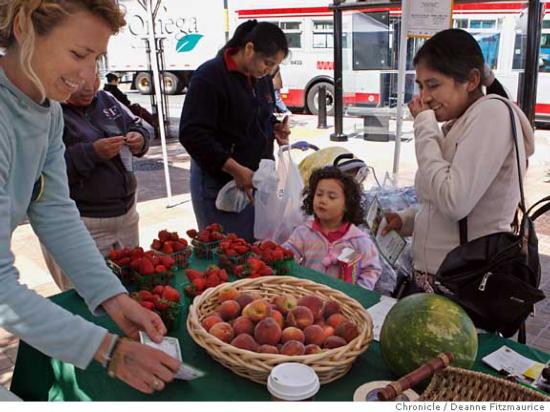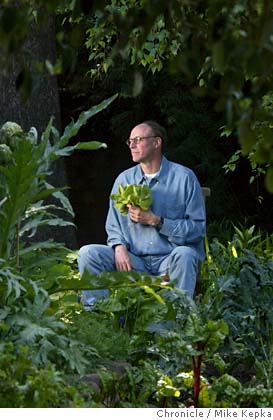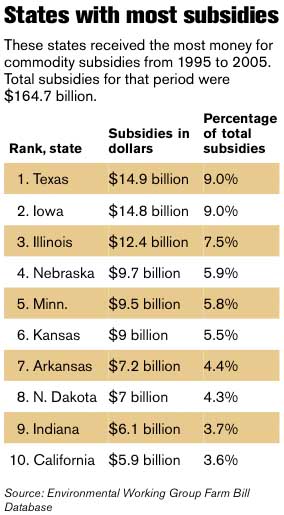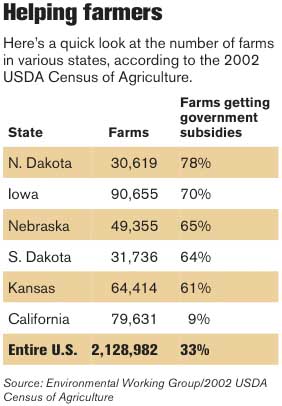The new food crusade
Organic farms, conservation, fruits and veggies in schools -- the Bay Area leads the charge to change how Congress subsidizes farming
Carol Ness, Chronicle Staff Writer
Tuesday, July 10, 2007
It was almost accidental activism. Acme Bread's Steve Sullivan was on a class trip to Washington, D.C., with his 13-year-old daughter when their flight home was canceled. A scramble to rebook ended with the Berkeley food artisan and his family seated almost across the aisle from California Sen. Dianne Feinstein.
So he handed her a copy of his new favorite book, "Food Fight," by Sonoma County author Daniel Imhoff. The book is a call to arms, urging Congress to use the 2007 farm bill to put more healthful food on people's plates.
The bill, which in recent years has totaled about $70 billion annually, comes up about once every five years. Although the farm bill has far-reaching consequences for the food supply, most people outside the Midwestern Farm Belt, which gets huge farm bill subsidies, have ignored it.
This year, things are different. Sullivan's trip down the aisle, and the book, are part of a wave of populist activism, much of it centered in the Bay Area, that is trying to change how a big chunk of farm bill money is spent.
The short version of the argument -- and nothing is short when it comes to the mind-numbing, complex farm bill -- is that the bill subsidizes the overproduction of corn and soy in the Midwest, which is driving up obesity and diabetes and polluting the land. Instead, they say, the farm bill should put more money into sustainable and organic food production, agricultural conservation and efforts to put a higher priority on fresh, local fruits and vegetables.
Their slogan: It's the food, health and farm bill.

"I want you to realize how many people in the Bay Area are talking about this," Sullivan said he told Feinstein.
Earlier, when the class visited a Feinstein constituent breakfast, he'd asked her the key question fueling the push for change: Have you ever considered using the farm bill to improve childhood nutrition, public health, pollution problems, environmental quality and farmer incomes?
"I don't know if she's just a good actress or what," Sullivan recounted. "But she stopped, her jaw dropped, and she said, 'I haven't. That's a really good way of thinking about it.' "
What happens to the farm bill this time around could turn on such moments. This year's burst of activism rises from the national trend toward local, sustainable and conscious eating -- consumers who want to know what they're eating, where it comes from and how it is produced.

Michael Pollan, the sustainable food movement leader and UC Berkeley professor and writer, has led the charge, starting with his best-selling "The Omnivore's Dilemma" and in articles and public appearances. A Pollan-moderated forum on the farm bill attracted a crowd of 700 to UC Berkeley's Wheeler Auditorium this year.
Similar forums have sprouted at farmers' markets and community halls all over the country. Influential voices such as health guru Andrew Weil and author Barbara Kingsolver have taken up the cause and attracted overflow audiences.
Imhoff, a food policy writer whose "Food Fight" is in its second printing, was a guest on National Public Radio's "West Coast Live" in late June, broadcast from San Francisco's Ferry Plaza Farmers Market.
These writers are the public face of a movement being worked from the inside by broad coalition of farm, environment and anti-hunger groups, including the Watsonville-based California Coalition for Food and Farming and the Venice-based California Food and Justice Coalition.
California, long a sleeping tiger when it comes to the farm bill, has awakened, too. Although it's the biggest agricultural state, California grows mainly fruits and vegetables, which aren't considered commodity crops and have never been subsidized. But now the administration of Gov. Arnold Schwarzenegger and 26 members of California's congressional delegation are pressing for farm bill reform.
Cities such as San Francisco and Los Angeles have hopped on board, too. San Francisco Mayor Gavin Newsom got the U.S. Conference of Mayors to pass a resolution urging farm bill reform at its recent meeting in Los Angeles.
"This is the first time that the farm bill is being scrutinized by people outside the farm block," Imhoff said in an interview. "To change it, people have to realize how it affects their lives on a daily basis, and that's what's happening."
The juicy prize that's arousing new appetites is the subsidy program, which has totaled about $30 billion a year in recent years. Nutrition programs, including food stamps, consume another $30 billion-plus of the bill's funding. Conservation's share has risen to $8 billion. Champions of sustainability, organics and the like have always found themselves competing for crumbs around the edges.
Farm Belt politicians defend the subsidies as necessary to keep family farmers in business, secure the food supply, fuel the engines of trade, and keep the agribusiness economy revving high.
The reformers argue that the subsidies amount to price supports for junk food. They say subsidies encourage commodity growers to plant an oversupply of low-priced corn and soy, which is processed into high-calorie high-fructose corn syrup and soybean oil and fed to feedlot animals bound for burgerville. The result: cheap food full of added sugar and fat.
The retail price of fruits and vegetables doubled from 1985 to 2000, but the cost of added fats and sugars remained the same, according to a paper by University of Washington public health specialist Adam Drewnowski, published June 24 in Epidemiologic Reviews. The paper drew a direct connection between cheap corn- and soy-based food and the obesity and diabetes epidemics.
California's interest has been piqued, among other things, by the fact that, dollar for agricultural dollar, the Golden State is shortchanged.
California rice and cotton farmers pulled in $5.9 billion in subsidies between 1995 and 2005 -- but that put it behind nine other states, according to a searchable database published by the Washington- and Oakland-based Environmental Working Group, a key player in farm bill reform. Only 9 percent of California's farmers get any subsidy at all.
An interactive map on the site dramatically shows where the money goes -- and where it doesn't. Having the database online has been a major weapon for reformers, because it shows where the subsidy money is concentrated. The environmental group's own analysis concludes that two-thirds of the subsidy money for 2003 through 2005 went to just 10 percent of all recipients.
For all the family farms that subsidies help support, many corporate farms rake in more than $250,000 a year in subsidies, and a few earn more than $500,000.
"This is a food fight, but it's really a fight about money," the environmental group's executive director, Ken Cook, has said.
The farm bill reformers stopped short of pushing for subsidies for broccoli or peaches.
The ethanol craze has pushed corn prices up so high that projected subsidies have been reduced by $7 billion to $8 billion a year -- but the congressional budget process already has stripped that money out of 2007 farm bill.
Various proposals would further limit subsidies, a little or a lot. That would free money for programs that make it easier and less expensive for people to buy fruits and vegetables, for farmers to develop local markets for their crops, and for research into organic and sustainable farming techniques.
A model is the tiny farmers' market in San Francisco's Bayview-Hunters Point, which got a rare community food project grant from the farm bill for startup costs. The money also pays the handful of vendors $50 a week to underwrite low prices and to keep coming back, though they can't earn much. It's one of a very few such markets to get farm bill money.
On one recent Wednesday morning, market neighbor Mary Charles loaded up. For just $10, she bought four baskets of pesticide-free Yerena Farms strawberries as well as carrots, garlic, summer squash, lettuce, spring onions and chard grown in the neighborhood and at nearby Alemany Farm, which is the kind of program that could benefit from changes in the farm bill. It held its own farm bill forum this year.
Charles could buy lots more food energy -- calories -- if she bought processed food across the street at the corner store. But she is diabetic, and she cooks for her four kids and two grandkids. Putting fresh produce on their plates is the best thing Charles can do for her family's health, she says, and she stops by the farmers' market every week.
"It's a good thing to have in the neighborhood to change people's ideas about how to eat," Charles says.
Another example is a pilot program, rolled out in the 2002 farm bill, that gives schools $92 extra per child to be spent just on fruits and vegetables. The program hasn't reached California, but a change being pushed in the 2007 farm bill would extend it to all 50 states.
In the 2002 farm bill, community food projects like the Bayview market got a total of $5 million -- about one-third of the amount that a single Arkansas rice cooperative earned in crop subsidies in 2005. The community projects' share could rise to $30 million under changes proposed in the 2007 farm bill, but final action is far off.
Conservationists also embraced broad reform this time around, according to Ralph Grossi, a Marin County beef rancher and president of American Farmland Trust.
"This time, our group made the determination that just focusing on conservation is not enough," he said.
Another reason is that while Congress has approved many conservation programs in principle, it hasn't come through with the money to fund many of them.
How far the reform movement can push Congress will start to play out late this month, and if it's not exactly a summer blockbuster, the lobbying has been intense.
California has extra muscle in this time around, with Democrats back in power, San Francisco's Nancy Pelosi as House Speaker and Rep. Dennis Cardoza, D-Atwater (Merced County), sponsor of the reformist Eat Healthy America Act, sitting on the Agriculture Committee.
Yet, last month, the commodities subcommittee -- the one in charge of subsidies -- refused to consider any changes and voted to extend the current farm bill for another two years, past the next presidential election.
That set up a showdown, scheduled for July 17-19 in the House Agriculture Committee. The Senate's Agriculture Committee will have its own go-round. Later, the appropriations committees of both houses will decide which programs will actually be funded.
And this is where Feinstein comes in -- and, potentially, "Food Fight."
"People hand her things all the time," her spokesman, Scott Gerber, said Monday. "She hasn't had a chance to read it."
But, he added, "It's still early."
______________________________________________________________
States with most subsidies
These states received the most money for commodity subsidies from 1995 to 2005. Total subsidies for that period were $164.7 billion.
______________________________________________________________
Helping Farmers
Here's a quick look at the number of farms in various states, according to the 2002 USDA Census of Agriculture.
_________________________________________________________
To learn more
Online resources for farm bill information:
- U.S. Department of Agriculture: www.usda.gov/wps/portal/usdahome
- California Department of Food and Agriculture: www.cdfa.ca.gov/farmbill07
- Environmental Working Group Interactive Farm Bill Database: farm.ewg.org/sites/farmbill2007/index.php
- California Food and Justice Coalition: www.foodsecurity.org/california/Farm_Bill.html
- California Coalition for Food and Farming: www.calfoodandfarming.org
- Food Fight: www.watershedmedia.org/foodfight_overview.html
- Community Alliance With Family Farmers: www.caff.org
- American Farmland Trust: www.farmland.org
- Sustainable Agriculture Coalition: www.msawg.org
- Western Growers: www.wga.com
- Organic Farming Research Foundation: www.ofrf.org/index.html
E-mail Carol Ness at cness@sfchronicle.com.
http://sfgate.com/cgi-bin/article.cgi?f=/c/a/2007/07/10/MNGNUQTQIT1.DTL
This article appeared on page A - 1 of the San Francisco Chronicle



